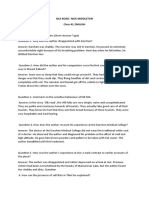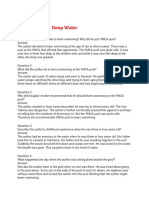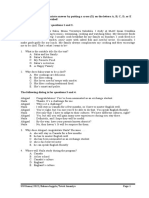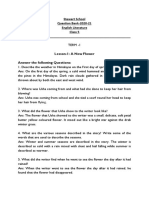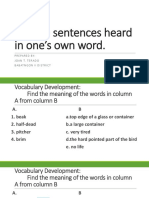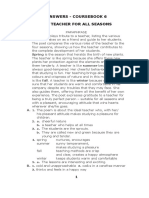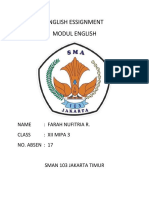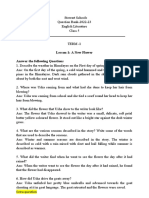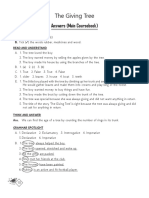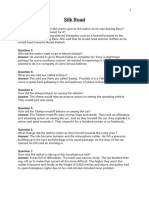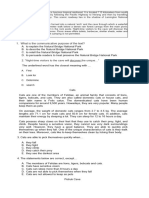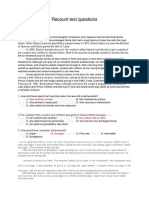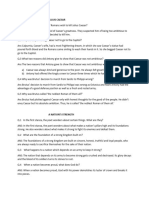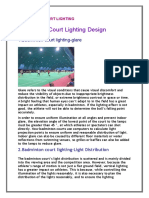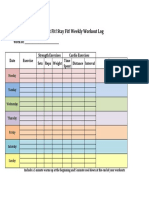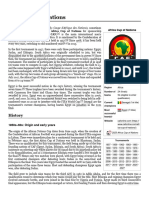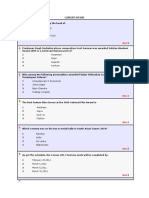s1 Return To Air Notes
Uploaded by
umjadon2s1 Return To Air Notes
Uploaded by
umjadon2Session:2023–2024
Grade: S1 Subject: English Ch 8-Return to Air
I. Answer the following questions.
1. What were the ponds, in the author’s village generally used for?
Ans. The ponds in the author’s village were very big, so at the one end people bathed, and at the other end they
fished.
2. Why did the author not want to dive?
Ans.The author did not want to dive because she had to take her glasses off to go into the water and she couldn’t see
without them. She did not want to dive without being able to see clearly.
3. What is duck -diving? How were the children taught, by the instructor, to duck dive?
Ans. Duck-diving is diving nose first into the water. The swimmer swims on the surface of the water and suddenly up-
ends herself/ himself just like a duck, and dives down deep into the water, swims about a bit underwater and then
comes up again. The swimming instructor taught the children to duck-dive by throwing a brick in the water. It was a
brick with a bit of old white flannel around it, to make it show up underwater. The children had to swim down to the
bottom of the pond, pick up the brick and bring it up again.
4. What did the swimming instructor throw in the pond? What were the instructions?
Ans. The swimming instructor threw a brick in the pond. It was a brick with a bit of old white flannel around it, to
make it show up under water. The instructions were to swim down to the bottom of the pond, pick up the brick and
bring it up again.
5. How does the narrator describe the changing colour of water? Why do you think the colour changed?
Ans. The author says, that at first the water was like a thick greenish-brown lemonade. Further down, it became just a
dark blackishbrown. The colour changed on going deeper because less sunlight reached this depth.
6. What were the narrator’s fear?
Ans. The narrator feared that she might get lost underwater. Perhaps she had swum underwater too far. Perhaps she
would come up at the far end of the pond, amongst all the fishermen and perhaps get a fish hook caught in her, or
perhaps she just wasn’t going to find the top and the air again. She also feared that she was swimming up too slowly
and wouldn’t reach the surface in time.
7. How was the narrator greeted when she reached the surface?
Ans. On reaching the surface, the narrator was greeted with a shouting from the bank. The children were cheering and
shouting and the instructor was hallooing with his hands around his mouth.
8. What had she got from the bottom of the pond?
Ans. The narrator had picked up a tin from the bottom of the pond. It was just about the size and shape of a brick. It
was an old tin box with no paint left on it, with brown-black slime from the bottom of the ponds. It was as heavy as a
brick because it was full of mud. There was nothing in it but mud.
You might also like
- Silk Road-Nick Middleton Class-XI, ENGLISHNo ratings yetSilk Road-Nick Middleton Class-XI, ENGLISH2 pages
- Soal Sumatif Tengah Semester Genap Bahasa Inggris Kelas Xi KumerNo ratings yetSoal Sumatif Tengah Semester Genap Bahasa Inggris Kelas Xi Kumer14 pages
- B.INGGRIS Soal PAT XII MIPA IPS 2022-2023No ratings yetB.INGGRIS Soal PAT XII MIPA IPS 2022-202317 pages
- Stewart School Question Bank-2020-21 English Literature Class 5100% (3)Stewart School Question Bank-2020-21 English Literature Class 522 pages
- Try Out Ujian Nasional SMP TAHUN PELAJARAN 2010/2011 Lembar SoalNo ratings yetTry Out Ujian Nasional SMP TAHUN PELAJARAN 2010/2011 Lembar Soal10 pages
- Soal Sumatif Tengah Semester Genap Bahasa Inggris Kelas Xi Kurikulum Merdeka100% (1)Soal Sumatif Tengah Semester Genap Bahasa Inggris Kelas Xi Kurikulum Merdeka7 pages
- Try Out Ujian Nasional SMP TAHUN PELAJARAN 2010/2011 Lembar SoalNo ratings yetTry Out Ujian Nasional SMP TAHUN PELAJARAN 2010/2011 Lembar Soal12 pages
- DLP in Science (Different Sources of Water)No ratings yetDLP in Science (Different Sources of Water)6 pages
- Arsip Soal PAT SMT 2 Kelas 10 Kurmer - B.ing Paket 1No ratings yetArsip Soal PAT SMT 2 Kelas 10 Kurmer - B.ing Paket 112 pages
- 2023729-One Stranded Bus and A Pond QB (2023 - 24)No ratings yet2023729-One Stranded Bus and A Pond QB (2023 - 24)2 pages
- Un - Bhs. Inggris Klinik Pendidikan Global Mandiri: Kevin@yahoo - Co.idNo ratings yetUn - Bhs. Inggris Klinik Pendidikan Global Mandiri: Kevin@yahoo - Co.id11 pages
- English 8 Module 6 Quarter 3 Bobby and Kates AcademyNo ratings yetEnglish 8 Module 6 Quarter 3 Bobby and Kates Academy9 pages
- Soal Assesment Genap Bhasa Inggris Kls 10 2024No ratings yetSoal Assesment Genap Bhasa Inggris Kls 10 20245 pages
- Test Name Result Biological Ref. Interval Method: Sodium FluorideNo ratings yetTest Name Result Biological Ref. Interval Method: Sodium Fluoride5 pages
- Singles Rankings: Numeric List For: 29 May 2023No ratings yetSingles Rankings: Numeric List For: 29 May 202330 pages
- Download Full Coaching youth basketball 5th ed Edition Don Showalter PDF All Chapters100% (8)Download Full Coaching youth basketball 5th ed Edition Don Showalter PDF All Chapters75 pages
- Download ebooks file Referees Match Officials and Abuse Routledge Focus on Sport Culture and Society 1st Edition Webb all chapters100% (1)Download ebooks file Referees Match Officials and Abuse Routledge Focus on Sport Culture and Society 1st Edition Webb all chapters65 pages
- Download No Malice My Life in Basketball or How a Kid from Queensbridge Survived the Streets the Brawls and Himself to Become an NBA Champion Metta World Peace ebook All Chapters PDF100% (2)Download No Malice My Life in Basketball or How a Kid from Queensbridge Survived the Streets the Brawls and Himself to Become an NBA Champion Metta World Peace ebook All Chapters PDF65 pages
- Simple Strength For Difficult Times: An 8-Week Progressive PlanNo ratings yetSimple Strength For Difficult Times: An 8-Week Progressive Plan3 pages
- Liste Des Ressortissants Congolais Présentement Dans La Province de HubeiNo ratings yetListe Des Ressortissants Congolais Présentement Dans La Province de Hubei12 pages
- Bill West - Capers With Paper A Complete Paper Tearing Act To RhymeNo ratings yetBill West - Capers With Paper A Complete Paper Tearing Act To Rhyme8 pages
- Caster Semenya: Gods and Monsters Brenna MunroNo ratings yetCaster Semenya: Gods and Monsters Brenna Munro15 pages
- Current Affairs: Assamese Dogri Gujarati KonkaniNo ratings yetCurrent Affairs: Assamese Dogri Gujarati Konkani5 pages
- Wendler 531 Program Spreadsheet & CalculatorNo ratings yetWendler 531 Program Spreadsheet & Calculator7 pages
- Us - JuggerArizonaRulebook 2019-2020 - 52No ratings yetUs - JuggerArizonaRulebook 2019-2020 - 5210 pages
- Activities of Daily Living Instruction: General InstructionsNo ratings yetActivities of Daily Living Instruction: General Instructions1 page
- Link Pendaftaran KOSN, KSN, FLS2N, PENTAS PAINo ratings yetLink Pendaftaran KOSN, KSN, FLS2N, PENTAS PAI4 pages
